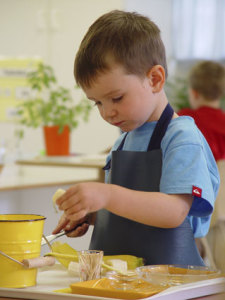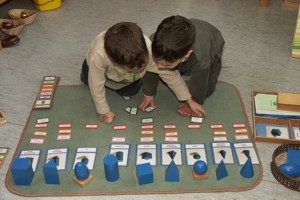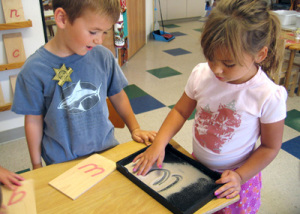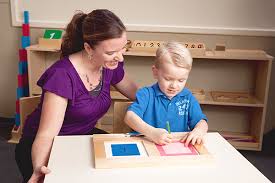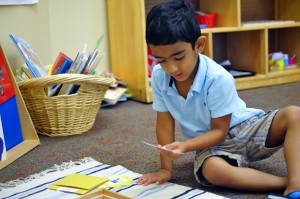Some people may wonder out of all the educational philosophies, why choose to pursue the Montessori method? After being in a Montessori environment and studying the method, I still have a hard time articulating our reasons. I tend to stumble over my words and end up saying something like, “You just have to see it” or “It just makes sense.”
I think you really do have to see the Montessori method in action to see the benefit. There are so many facets and real-life benefits outside the classroom that are hard to explain in 1 to 2 sentences. But, if I had to explain why a 100+ year old philosophy is still current and works even amid changing culture, this is what I’d say:
1. Montessori moves from concrete to abstract.
The first thing I noticed and appreciated about the Montessori environment was how all the materials and subject matter moved from the concrete to the abstract. The child is able to interact with concepts and ideas rather than simply memorize facts.
The child quantifies a number in math, understands place value by having a visual representation of ones, tens, hundreds, and thousands, develops their senses by tactile experiences with rough and smooth boards, sound cylinders, color boxes, and learns land and water forms by pouring water into miniature land and water formations. I could go on and on.
2. Montessori facilitates a natural love for learning.
I’ve heard some say Montessori is too strict and others say it’s too free. The truth is really somewhere in between. I love the idea of following the child, it’s hard to adjust to from our society that demands the child adapt to the adult’s pace, but once you begin you really do see how much more the child sees, enjoys, and discovers about the world.
The Montessori materials naturally bring about the inquisitive nature of the child and allows them to think of new ways to do things. They open up the child to learn for the themselves. It teaches them how to discover, but doesn’t give a step-by-step direction.
3. Montessori seeks to educate the whole child.
Montessori takes the child’s education outside the classroom. It affects how they interact with others, the freedoms they have in the home, teaches them to care for their self, their environment, and others, and teaches them how to be an active participant in their learning and environment.
Montessori equips the child for everyday life, giving them practical skills which gives them purpose and enables them to be a contributing member of their family, classroom, and community. Montessori sees the child not just as a miniature person, but as a able-bodied and capable person.
4. Montessori abstains from rewards.
There are no gold stars in a Montessori environment. No grades. No “Look how smart you are!” No reward for learning other than the intrinsic joy the child receives when they discover something new or realize they’ve acquired a new skill. (When Montessori does praise, it’s very specific. For example, “I like how diligently you’re working on your penmanship.”)
One of the defects of our education system which has, in turn, affected our society is the idea we need to have a reward for every accomplishment. Whether a child being toilet trained receives candy for eliminating in an appropriate way, or if a child hasn’t thrown a fit they can have dessert, etc.
It all conditions the child to perform for a reward. The child then expects a handout when they do well or what is expected from them rather than doing well for the joy of learning or behaving appropriately because they realize it’s what a contributing, helpful member of society does.
When we offer rewards we are training them to perform for the reward rather than the intrinsic value of learning, possessing a skill, or contributing to their community (family, class, etc).
5. Montessori focuses on the individual child and their potential.
The biggest problem I see with traditional schooling is having a set curriculum based on the child’s age and expecting all children to study and progress through that material at the same pace and each attain optimal results. It just doesn’t happen. It won’t happen.
Why? Because no two children are at the same spot in their development.
Just think of the student who is bored in a subject matter, because he or she already understands the concepts and the work is too easy for them. While on the other hand, another student may seriously struggle with the same concept. The problem comes with the bored child getting in trouble and losing interest in learning and having to wait for his or her peers to catch up, while the struggling child feels less than or embarrassed that they are “failing.”
In a Montessori environment, both students can meet their full potential and work at their own pace. They don’t have to wait for other students to catch up or feel like a failure for not understanding fractions. Each child learns differently and at a different pace, that’s why Montessori’s recognition of sensitive periods in the child and the teacher’s daily observation are so important.
While some may say this causes more work for the teacher, in a Montessori environment it doesn’t. The scope and sequence of each subject area (math, language, practical life, sensorial, culture/geography, botany, zoology, etc) is the same for each student. The materials are already prepared and present on the shelf. All the teacher has to do is be aware of where the student is and be ready to give the next lesson in the sequence.

